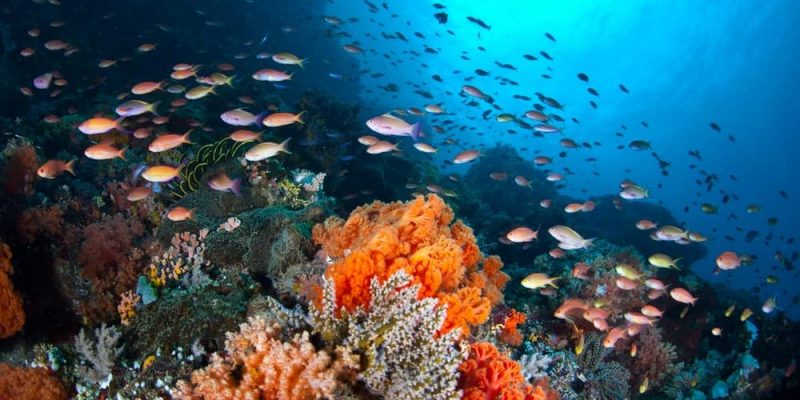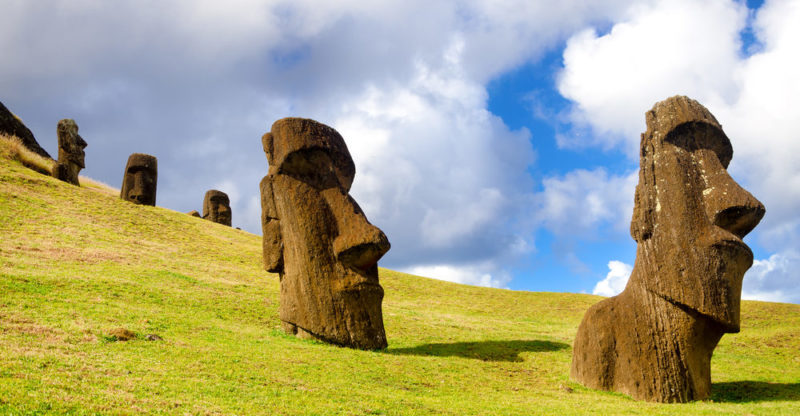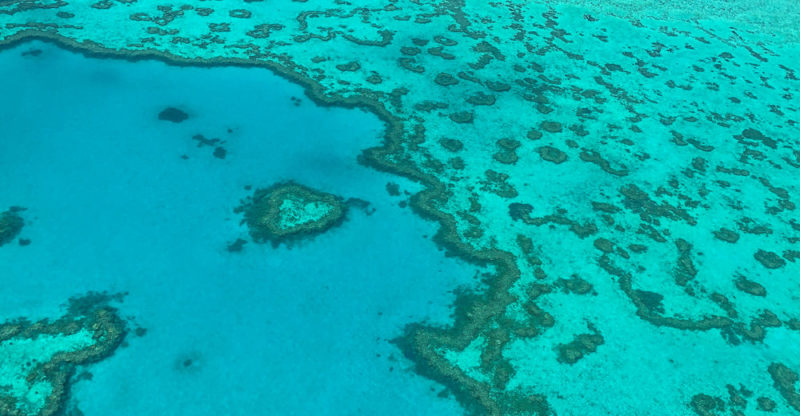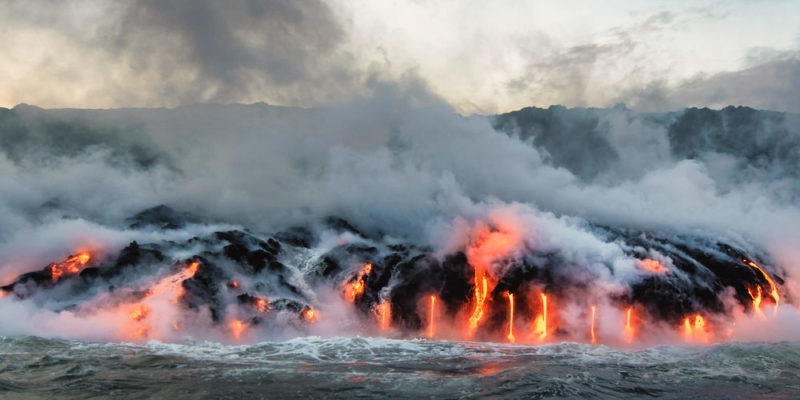We explain what the Pacific Ocean is, how much it extends and what its flora and fauna are like. Also, what are its characteristics, climate and more.
What is the Pacific Ocean?
We call the Pacific Ocean or Great Ocean the largest, deepest and most violent of the planet's oceans . Its name is attributed to Fernando de Magallanes, who found its waters very peaceful . However, the name assigned by the first European to contemplate its waters in 1513, the Spanish explorer Vasco Núñez de Balboa, was “Mar del Sur”.
The Pacific Ocean is often found, in western world maps, relegated to the edges of the map, unlike the Atlantic, which is a much more central ocean in our imagination. Contrary to its name, it is located in a highly dangerous region, where earthquakes , volcanic eruptions, typhoons and hurricanes are frequent .
This great ocean is divided into two:
- North Pacific Ocean. Above the equator
- South Pacific Ocean. Below the equator line.
Where is the Pacific Ocean located?
The Pacific is located in the intermediate space between the coasts of America , Asia and Oceania . Its waters are part of the territory of 53 different countries.
In addition, it borders the Arctic Ocean (and the Bering Sea) to the north and Antarctica (and the Ross Sea) to the south.
Expanse of the Pacific Ocean

The extension of the Pacific is 15,000 kilometers from North to South . It reaches its greatest width (19,800 km) at 5 degrees north latitude, that is, between Indonesia and the Colombian coasts.
It covers a total area of 155,557,000 square kilometers , which is equivalent to one third of the planet Earth . In addition, the waters of the Pacific represent 43% of the planet's water: some 169.2 million cubic kilometers of salt water.
Pacific Ocean density
The density of oceanic water is closely related to its salinity level , which varies in the case of the Pacific depending on its latitude.
The waters near the equator are less brackish due to the frequent rainfall in that area. On the other hand, they are also less brackish in the polar regions due to their little evaporation . The mean salinity of the Pacific is 32.5% (about 34 grams per liter).
Flora and fauna of the Pacific Ocean

The greatest biological wealth of the Pacific Ocean is centered on its margins, where the flow of currents maintains a great diversity of animal and plant species . Especially the large coral reefs are veritable explosions of ocean life.
Marine life ranges depending on depth, from plankton on the surface to large predators like sharks . There are even species adapted to life in the deep ocean, where there is no light and the pressure is overwhelming.
The Pacific is an important source of fish for the fishing industry , such as anchovy or anchovy, highly demanded in the world.
The waters near the pole , on the other hand, are home to marine life adapted to the frozen environment, such as seals , walruses, killer whales , and whales . The latter are under ecological protection as hunters from Asia (especially Japan ) and Chile have hunted them for decades for their valuable oil.
Pacific Ocean Climate
In the Pacific zone there are five well differentiated climatic regions:
- The calm zone of the equator. Located in the intertropical zone, trade winds and constant temperatures of between 21 and 27 degrees Celsius predominate .
- Middle latitudes. Located to the north and south of the equator, they have the presence of counter-trade winds with pronounced seasonal changes.
- The tropics. The great cooling zones of the planet, due to its enormous mass of water, since most of the islands are in the equatorial region.
- The monsoon region. Located in the western Pacific, between Japan and Australia, it has winds that blow from the continents to the ocean in winter and in the opposite direction in summer, causing a very characteristic rainy season known as the monsoon.
- The typhoon region. This region has a presence in the northwest of the ocean, and has the ideal pressure and temperature conditions for typhoons to proliferate, that is, the frequent tropical cyclones in Japan, Hawaii, the Philippines and Hong Kong.
Pacific Ocean Islands

The Pacific has thousands of different islands, most of them belonging to Oceania, grouped into three distinctive regions:
- Melanesia. New Guinea, Papua New Guinea, Indonesia, New Caledonia, Zenadh Kes (Torres), Vanuatu, Fiji, and the Solomon Islands.
- Micronesia. Mariana Islands, Guam, Wake Island, Palau, Marshall Islands, Kiribati, Nauru, and the United States of Micronesia.
- Polynesia. New Zealand, Hawaii, Rotuma, Midway, Samoa, American Samoa, Tonga, Tovalu, Cook Islands, French Polynesia, and Easter Island.
- Galapagos Islands. Belonging to Ecuador.
- Aleutian Islands. Belonging to Alaska and the United States.
- Sakhalin and Kuril Islands. Belonging to Russia.
- Taiwan Belonging to the ROC and in dispute with the People's Republic of China.
- Philippines
- Islands of the South China Sea. Belonging to China .
- Indonesia.
- Japan and the Ryukyu Islands.
The Mariana Trench
It is known as the Mariana Trench to the deepest known part of all the world's oceans , located in the western Pacific, near the Mariana Islands and Guam. It has the shape of a scar or crescent, extending along 2,550 km of the earth's crust and reaching 69 km in width.Its maximum known depth is 11,034 meters , meaning that if Mount Everest were to fall standing upright in the Mariana Trench, its peak would remain 1.6 km below the water level.
The great coral barrier
 This is the name of the world's largest coral reef system , located off the northeast coast of Australia in the Coral Sea . Although its exact extension is indecipherable, it is estimated that it stretches over 2,600 kilometers.
This is the name of the world's largest coral reef system , located off the northeast coast of Australia in the Coral Sea . Although its exact extension is indecipherable, it is estimated that it stretches over 2,600 kilometers.It is made up of more than 2000 different coral reefs and some almost 1000 islands. Its magnitude is such that it is appreciable from space and contains one of the largest agglomerations of biodiversity in the world. For this reason, it has been declared a World Heritage Site by UNESCO in 1981 .
The Belt of Fire
 Also called the “Pacific Ring of Fire”, it is a region of the Pacific basin that is home to some of the largest volcanoes and supervolcanoes on the planet.
Also called the “Pacific Ring of Fire”, it is a region of the Pacific basin that is home to some of the largest volcanoes and supervolcanoes on the planet.In addition, the most intense seismic activities are recorded there , in a horseshoe-shaped pattern along 40,000 km of coasts in South, Central and North America, Russia, Japan, China, Korea, Asia Minor and Oceania .
452 volcanoes are concentrated in this area (75% of the world's active and inactive volcanoes) and 80% of the planet's earthquakes take place there.
The North Pacific Drift
Also known as the “North Pacific Current”, it is a slow warm water current that flows from west to east of the Pacific Ocean between the 40th and 50th parallel.It is caused by the collision of the Kuro Shio current , which runs north from the Japanese coast, with the Oya Shio current, which flows south from almost the Arctic, in an opposite clockwise direction. This is one of the main ocean currents in the Pacific Ocean.
The above content published at Collaborative Research Group is for informational and educational purposes only and has been developed by referring reliable sources and recommendations from technology experts. We do not have any contact with official entities nor do we intend to replace the information that they emit.
Luke is passionate about fostering student involvement and connection. He studied psychology for his major and likes learning about the past. Luke aims to specialize in artificial intelligence and cybersecurity. .
Leave a reply
Your email address will not be published. Required fields are marked *Recent post

Sport: What Is It, Types, Risks, Features, Characteristics and Examples

Dogs: Emergence, Features, Characteristics, Feeding and Breeds

Story: Definition, Elements, Structure, Features and Characteristics

